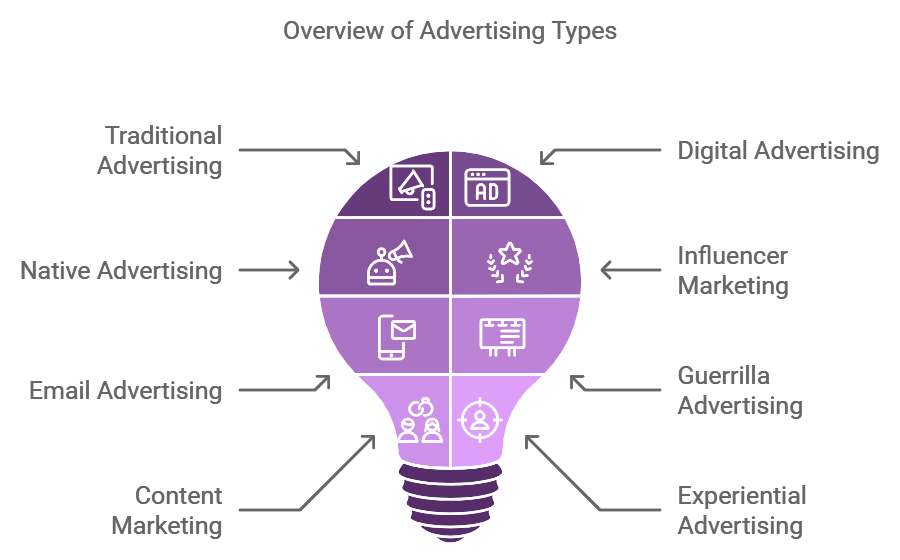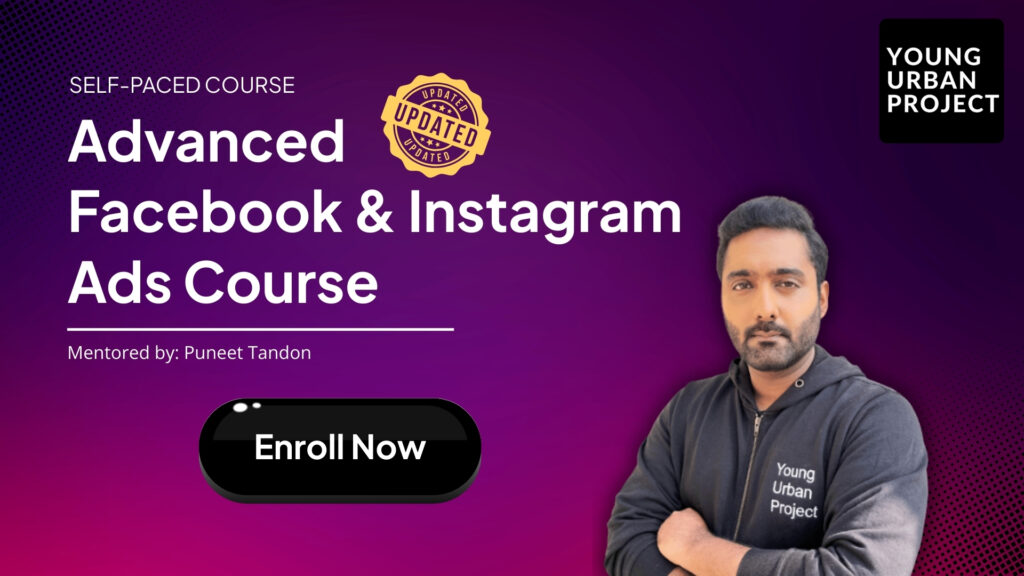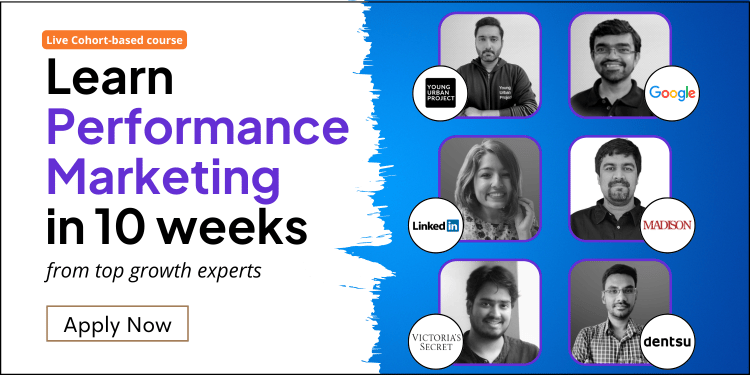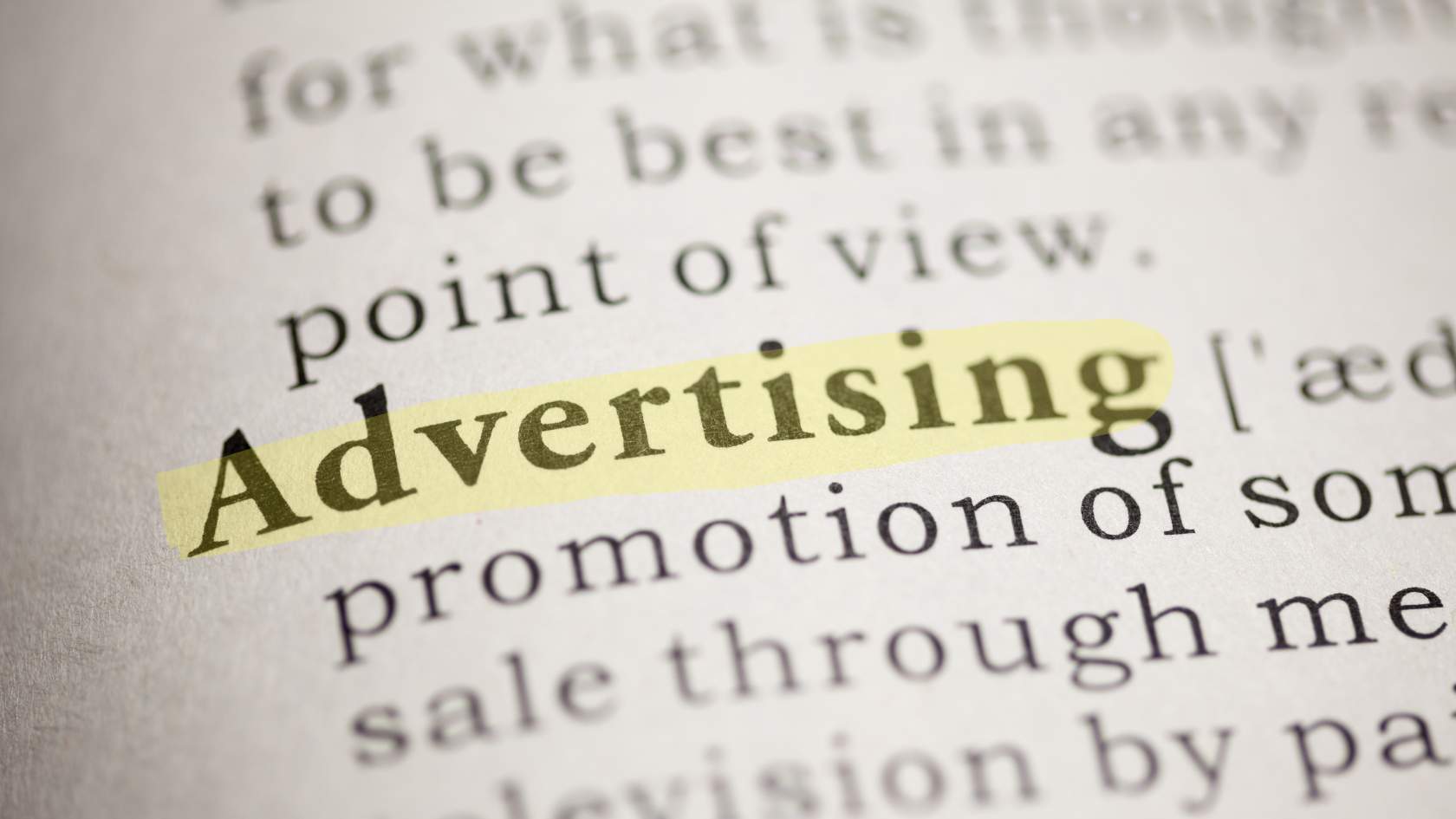Think of the last thing you bought. Now, ask yourself: why that brand? Why that product? Whether you realize it or not, advertising probably played a part. Advertising isn’t just a flashy TV commercial or a catchy jingle—it’s a powerful, strategic message that influences perceptions and drives choices.
From the billboards on your commute to the sponsored posts in your social feed, ads come in all shapes, forms, and styles. But in a world where consumers are exposed to thousands of marketing messages every day, choosing the right types of advertising is crucial to making a memorable impact. What makes some ads captivating and others forgettable? And how can businesses ensure their advertising reaches, engages, and converts the right audience? Let’s understand the world of advertising and uncover the diverse methods that brands use to stand out in today’s crowded marketplace.
Table of Contents
What is Advertising?
At its core, advertising is a way of communicating with your audience to inform, persuade, and remind them about your products or services. But in a broader sense, advertising is about shaping perception and creating a lasting brand impact. Think about Apple’s “Think Different” campaign or Nike’s “Just Do It”—these ads weren’t just selling products; they were selling a lifestyle, a philosophy.
The Goals of Advertising
Advertising typically has one or more of the following objectives:
- Brand Awareness: Reaching as many people as possible to make your brand recognizable.
- Customer Acquisition: Converting potential customers who haven’t yet interacted with your brand.
- Retention and Loyalty: Keeping existing customers engaged and loyal to your brand.
- Revenue Generation: Driving sales and direct ROI from ads.
By identifying your goals, you can select the most effective types of advertising for your brand.
Also Read: What is Advertising Copy and its Types
Types of Advertising: Finding the Right Fit for Your Brand
Advertising isn’t a one-size-fits-all solution; the approach you choose should align with your brand’s goals, audience, and industry. Here’s a comprehensive overview of the most impactful types of advertising today:

1. Traditional Advertising
Traditional advertising encompasses established methods that have stood the test of time. While often viewed as less innovative than digital approaches, these methods can still effectively reach specific audiences.
Print Advertising
This includes newspapers, magazines, brochures, and flyers. Print advertising can feel more personal and trustworthy to certain demographics, particularly older consumers. High-end brands often utilize print media to target affluent readers. For example, luxury car manufacturers may choose to feature their vehicles in prestigious lifestyle magazines.
Broadcast Advertising
This method involves advertisements on television and radio. Despite the rise of streaming platforms, traditional TV advertising remains effective for brands looking to reach a large audience quickly. The IPL commercials are perhaps the most well-known example of this, where brands aim for maximum exposure and memorability.
Outdoor Advertising
Billboards, transit ads, and digital displays are prevalent in this category. Outdoor advertising is designed to be eye-catching and deliver a clear message quickly. Brands like McDonald’s utilize billboards with simple slogans and striking images to attract hungry customers on the go.
Also Read: Marketing Vs Advertising
2. Digital Advertising
Digital advertising has revolutionized the marketing landscape, enabling brands to connect with consumers in innovative and highly targeted ways.
Search Engine Advertising
Utilizing platforms like Google Ads, SEA allows businesses to display ads on search engine results pages. This method is particularly effective for capturing leads from users actively searching for products or services. Brands can target specific keywords to ensure their ads reach relevant audiences.
Social Media Advertising
Platforms like Facebook, Instagram, and Twitter enable businesses to create targeted ads that appear in users’ feeds. The ability to segment audiences based on interests, behaviors, and demographics makes social media advertising a powerful tool. For instance, fashion brands often use Instagram’s visual nature to showcase products and engage users.

CheckOut: Best Facebook Ads Course
Display Advertising
This includes banner ads that appear on websites, apps, and emails. Display ads can be static or animated, capturing users’ attention while they browse online. Effective display advertising relies on strong visuals and concise messaging to drive clicks.
Video Advertising
With platforms like YouTube and TikTok, video advertising has gained immense popularity. These ads can be skippable or non-skippable, and they allow brands to tell stories, demonstrate products, or provide entertainment. A notable example is Apple’s use of emotional storytelling in their video ads, showcasing the human impact of their technology.
3. Native Advertising
Native advertising seamlessly blends with the content around it, making it less intrusive than traditional ads. These ads match the format and style of the platform they appear on, providing value while promoting a product or service. Sponsored articles, social media posts, and video content often fall into this category. BuzzFeed’s sponsored quizzes are a classic example, where brands engage users through entertaining content that feels organic.
4. Influencer Marketing
Influencer marketing leverages the popularity and credibility of social media influencers to reach targeted audiences. Brands collaborate with influencers who align with their values, allowing them to promote products in an authentic way. For example, a beauty brand might partner with a makeup artist to create tutorials featuring their products. Influencer marketing has proven effective because consumers often trust recommendations from individuals they follow.
5. Email Advertising
Email advertising involves sending targeted messages to subscribers, often in the form of newsletters, promotional offers, or product updates. It remains one of the most direct and personalized forms of advertising. Brands can segment their email lists based on user behavior and preferences, ensuring that each message is relevant. For instance, e-commerce companies frequently send cart abandonment emails to remind customers of items they left behind.
6. Guerrilla Advertising
Guerrilla advertising is all about creativity and surprise. This unconventional approach focuses on low-cost, high-impact campaigns that captivate audiences in unexpected ways. Brands might employ street art, flash mobs, or stunts to create buzz. Red Bull’s extreme sports events exemplify guerrilla advertising, effectively aligning their brand with excitement and adventure.
7. Content Marketing
Content marketing is not overtly promotional but focuses on delivering valuable, informative content to engage an audience. Blogs, articles, videos, and infographics fall under this category. For instance, HubSpot provides a wealth of marketing resources that help establish its authority while subtly promoting its software solutions.
8. Experiential Advertising
Experiential advertising creates immersive experiences that allow consumers to engage with a brand physically. This could be through pop-up shops, interactive installations, or events. Brands like Coca-Cola have successfully used experiential marketing to connect with consumers on a personal level, fostering emotional connections that drive loyalty.

Enroll Now: Performance Marketing Training
Why is Advertising Important?
1. Builds Brand Awareness and Recognition
Advertising is crucial for introducing your brand to potential customers. It creates awareness and helps establish your identity in a crowded marketplace. Over time, effective advertising fosters brand recognition, making it easier for consumers to recall your brand when they need a product or service.
2. Fuels Sales and Growth
A well-executed advertising strategy can lead to increased sales and revenue growth. By reaching your target audience with compelling messages, advertising drives consumer interest and prompts action. For example, a limited-time promotion can create urgency, encouraging customers to make a purchase.
3. Establishes Brand Loyalty
Consistent and value-driven advertising reinforces relationships with existing customers. By keeping your brand top-of-mind and providing value through ads, you nurture loyalty. When customers feel connected to a brand, they’re more likely to choose it over competitors in the future.
4. Enables Competitive Differentiation
In a crowded marketplace, advertising allows brands to differentiate themselves from competitors. Unique positioning and messaging highlight what sets your brand apart, making it easier for consumers to understand why they should choose you. For example, a brand that emphasizes sustainability can attract environmentally conscious consumers.
5. Inspires and Educates Consumers
Advertising is not just about selling; it’s also about providing value. Inspirational ads can resonate deeply with audiences, creating emotional connections. Educational advertising, on the other hand, informs consumers about product features and benefits, enabling them to make informed decisions.
Best Advertising Examples
OnePlus Diwali Ad Campaign 2024 – #MakeItSpecial for Everyone
OnePlus launched a touching Diwali campaign titled “#MakeItSpecial for Everyone,” emphasizing compassion and inclusivity, even for pets.
Heartwarming Story
The campaign features a video ad of a family preparing for Diwali. While wrapping gifts, their dog curiously collects some presents and delivers them to stray animals. This act beautifully illustrates the spirit of sharing and joy during the festival.
Message of Inclusivity
The campaign promotes inclusivity, reminding viewers that Diwali is about spreading joy to all, including overlooked members of the community, like stray animals.
Creative Concept
Conceptualized by OnePlus’s in-house team, the ad captures genuine moments under director Kameron, making it an emotional highlight of the season and a true celebration of kindness.
Spotify: ‘Spreadbeats’ by FCB New York
Spotify launched a surprising music video ad called “Spreadbeats”
Unique Approach
Featuring vibrant retro graphics, the B2B initiative creatively targets brands, marketers, and agencies, offering an engaging experience.
Engaging Message
The ad breaks away from traditional formats, making it a standout campaign that captures attention and invites collaboration.
Grand Theft Auto 6
The highly anticipated Grand Theft Auto 6 (GTA6) is set to launch in 2025, following the enduring popularity of GTA5 since 2013.
Teaser Success
In December 2023, Rockstar Games released a YouTube teaser ahead of schedule due to an unauthorized leak, garnering over 19 million views in just two weeks. The teaser features stunning cinematic graphics that pay tribute to viral clips from Florida.
Cultural Impact
Before the trailer launch, the gaming industry began referencing GTA6’s designs, highlighting the franchise’s cultural significance. Rockstar archived all social media posts except for the teaser image to create buzz.
Blockbuster Strategy
The trailer release was crafted like a blockbuster film launch, reflecting the interests of GTA fans—62% of whom are also cinema enthusiasts—showing how insights shape effective marketing strategies.
Online Advertising Techniques: How to Make Your Ads Effective in the Digital Space
1. Remarketing (or Retargeting)
Remarketing allows brands to reconnect with users who have previously visited their website but didn’t convert. By displaying tailored ads across the web, brands can remind potential customers about products they showed interest in, encouraging them to return and complete their purchase.
2. Programmatic Advertising
Programmatic advertising automates the ad buying process, using algorithms to target audiences based on specific criteria. This technology allows brands to deliver ads in real-time, optimizing ad spend by reaching the right people at the right time.
3. Influencer-Generated Content
Collaborating with influencers not only allows brands to reach wider audiences but also adds authenticity to their messaging. Influencer-generated content—whether through sponsored posts, stories, or videos—feels more relatable and engaging to followers, making it an effective advertising strategy.
4. Interactive Ads
Interactive ads invite users to engage, creating a more memorable experience. Quizzes, polls, and AR experiences encourage participation and can lead to higher engagement rates. For example, beauty brands often use AR filters on platforms like Instagram to let users virtually try on makeup.
Measuring Advertising Effectiveness
To understand the impact of advertising efforts, brands must measure performance through various metrics. Key performance indicators (KPIs) include:
- Return on Investment (ROI): Assessing the profitability of advertising campaigns.
- Click-Through Rate (CTR): Measuring the percentage of users who click on an ad.
- Conversion Rate: Evaluating the percentage of users who complete a desired action (e.g., making a purchase).
- Engagement Metrics: Tracking likes, shares, and comments on social media ads.
- Brand Awareness Surveys: Gauging changes in brand recognition and perception over time.
Conclusion: Finding the Right Advertising Mix
As you navigate the diverse types of advertising, remember that the most effective strategies combine various methods tailored to your audience and goals. By understanding the strengths and limitations of each type, you can create a cohesive advertising strategy that resonates with consumers and drives lasting brand loyalty.
Investing in thoughtful, creative advertising not only amplifies your brand’s voice but also establishes genuine connections with your audience. Whether you choose traditional methods, digital innovations, or a blend of both, the key is to remain adaptable and open to new opportunities as the advertising landscape continues to evolve.

